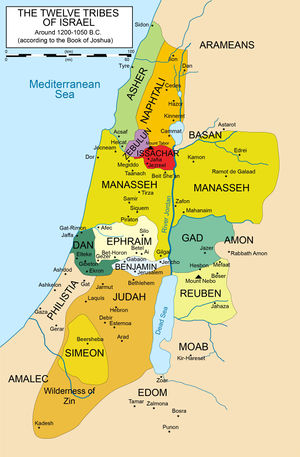Twelve tribes of Israel/es: Difference between revisions
PeterDuffy (talk | contribs) (Created page with "== Advertencia y bendición a las doce tribus ==") |
PeterDuffy (talk | contribs) (Created page with "Tras muchos años, los descendientes de los hijos de Jacob que vivían en Egipto se multiplicaron hasta tal punto, que el Faraón se sintió amenazado por su cantidad y su poder. Los esclavizó y ordenó que todos los varones hebreos fueran ahogados al nacer.") |
||
| Line 64: | Line 64: | ||
== Advertencia y bendición a las doce tribus == | == Advertencia y bendición a las doce tribus == | ||
Tras muchos años, los descendientes de los hijos de Jacob que vivían en Egipto se multiplicaron hasta tal punto, que el Faraón se sintió amenazado por su cantidad y su poder. Los esclavizó y ordenó que todos los varones hebreos fueran ahogados al nacer. | |||
<div lang="en" dir="ltr" class="mw-content-ltr"> | <div lang="en" dir="ltr" class="mw-content-ltr"> | ||
Revision as of 00:00, 10 January 2024
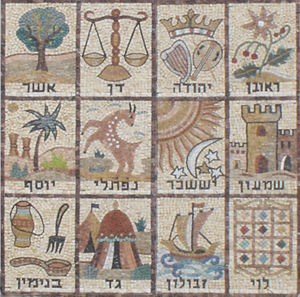
Se suele considerar que la historia de las doce tribus de Israel comienza con Abraham, el progenitor y primer patriarca del pueblo hebreo. Pero en realidad su historia en la Tierra comienza mucho antes, con la venida de Sanat Kumara, el Anciano de Días, que llegó en una misión de rescate en el momento pésimo y más oscuro de la historia de la Tierra.
El Consejo Cósmico que gobierna el destino de la Tierra decretó la disolución del planeta y sus evoluciones, porque todas las personas de la Tierra habían olvidado el Origen y la llama trina.
En ese punto, Sanat Kumara, jerarca de Venus, acudió al Consejo Cósmico y dijo: «Me ofrezco a ser el salvador de la Tierra. Me ofrezco a guardar la llama de la Tierra hasta que haya alguien entre los hombres que despierte hacia el conocimiento de la Ley». Sanat Kumara recibió la oportunidad de venir a la Tierra a guardar la llama.
The incarnation of the lightbearers
Cuando los portadores de Luz de Venus, Mercurio y otros hogares planetarios se enteraron de que Sanat Kumara se había ofrecido para defender las evoluciones de la Tierra, ellos se ofrecieron a ir con él; y fueron aceptados. Y así, cuando Sanat Kumara llegó a la Tierra, con él llegó un séquito de portadores de Luz para establecer Shambala, su retiro en la Isla Blanca del mar de Gobi (que ahora es el desierto de Gobi, en China).
Quienes vivieron con Sanat Kumara debían encarnar de acuerdo con un destino prestablecido entre las naciones de la Tierra. Su misión era ser portadores de Luz que enseñaran a la humanidad el camino de la Trinidad, el camino de la llama trina, el camino del fuego sagrado y que le recordaran su origen. Así, debían llegar a Oriente y a Occidente y debían venir a enseñar a los hombres el camino del Padre y el camino de la Madre.
En Occidente, los portadores de Luz que encarnaron para servir a la luz son conocidos como las doce tribus de Israel. En Oriente, ellos forman las escuelas de misterios que siguen la tradición del Gurú y el chela. En cada caso, este grupo de almas tiene la finalidad de transmitir, de generación en generación, en una cadena íntegra con su inicio en Lemuria, las verdaderas enseñanzas de la religión del Padre y la religión de la Madre.

Las doce tribus: progenie de Sanat Kumara y Abraham
En Occidente, la evolución de las doce tribus en la tradición judeocristiana ha sido una historia de desobediencia y castigo y luego redención. En el Antiguo Testamento hay una historia sobre el juicio al pueblo de Israel que se produce una y otra vez a través de evoluciones rezagadas.
La búsqueda en Occidente se ha centrado en torno a la meta de encontrar la gracia ante los ojos de Dios al encontrar al Cristo, el Mediador, y llegando a ser amigos de Dios, como lo fue Abraham a través de ese Cristo.[1] Este sendero se cumple en la persona de Jesucristo.
La historia escrita sobre estos portadores de Luz en Occidente, las doce tribus de Israel, comienza en la Biblia, en el Génesis, capítulo 12, cuando Dios promete la bendición a Abraham: «Y haré de ti una nación grande, y te bendeciré, y engrandeceré tu nombre, y serás bendición»[2].
En el capítulo 15, Dios dice a Abraham (cuando aún se lo conocía como Abram): «Mira ahora los cielos, y cuenta las estrellas, si las puedes contar. Y le dijo: Así será tu descendencia»[3]. Entonces Dios le dijo a Abraham que hiciera un sacrificio. Él así lo hizo y Dios les habló de un karma que le sobrevendría a su progenie:
Mas a la caída del sol sobrecogió el sueño a Abram, y he aquí que el temor de una grande oscuridad cayó sobre él. Entonces el SEÑOR dijo a Abram: Ten por cierto que tu descendencia morará en tierra ajena, y será esclava allí, y será oprimida cuatrocientos años. Mas también a la nación a la cual servirán, juzgaré yo; y después de esto saldrán con gran riqueza. [Esta es una profecía sobre el cautiverio de las doce tribus en Egipto].
Y tú vendrás a tus padres en paz, y serás sepultado en buena vejez. Y en la cuarta generación volverán acá; porque aún no ha llegado a su colmo la maldad del amorreo hasta aquí.[4]
Sanat Kumara eligió a Abraham como padre de los israelitas, el cual recibiría, en su vejez, gracias a Sarah, a su hijo Isaac. Isaac a su vez tendría a Jacob. Jacob traería al mundo a doce hijos, que serán los progenitores de las doce tribus.
Así, Abraham es el gran patriarca de los portadores de Luz, elegido para traer a la progenie de Alfa. Estas almas llegaron con la misión específica de ser testigos del Dios verdadero en medio de la idolatría, en medio de la gran oscuridad de Oriente Próximo, como la que se vio en Sodoma y Gomorra. Llegaron para ilustrar la bienaventuranza de servir a Dios, de recibir y conservar la profecía y las revelaciones y, sobre todo, ser el canal a través del cual naciera el Mesías.

Los doce hijos de Jacob
En 1900 a. C. aproximadamente Dios confirió su bendición a Isaac, hijo de Abraham: «Y se le apareció el SEÑOR esa misma noche y dijo: “YO SOY el Dios de tu padre Abraham; no temas, porque estoy contigo, y te bendeciré, y multiplicaré tu progenie por mi siervo Abraham”»[5]. Es muy curioso que el SEÑOR bendiga a cada generación de portadores de Luz, lo cual significa que la bendición no se produce de forma automática con la transferencia hereditaria, sino que llega a partir de su restablecimiento para cada generación.
El hijo de Isaac, Jacob, recibió a su vez la bendición del SEÑOR muchos años después y otra bendición cuando luchó con el ángel, el Arcángel Miguel, quien lo purificó de su mal permitiéndole así recibir la unción del nombre «Israel».[6]
Jacob tuvo doce hijos, nacidos de sus cuatro esposas. Estos fueron ungidos por Sanat Kumara como portadores de la progenie de luz para el cumplimiento final del destino de los portadores de Luz. Su hijo favorito fue el undécimo, José, a quien le hizo una túnica de diversos colores. Esta túnica es el símbolo del Cuerpo Causal de los hijos de Israel. Jacob eligió a José para que llevara esa túnica porque vio que este tenía la mayor manifestación de la conciencia Crística y que podía llevar la llama de la mezcla de todos los rayos de colores del Cuerpo Causal. José, por tanto, recibió su derecho de nacimiento de su padre, Israel.
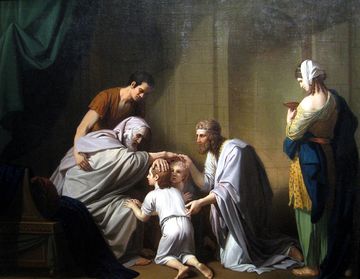
Pero los hermanos de José sintieron celos de él. Primero planearon matarlo, pero después decidieron venderlo como esclavo. José fue llevado a Egipto, donde se ganó la confianza del Faraón y llegó a ser su mano derecha. Cuando la sequía y el hambre acosaron la tierra, Jacob y sus once hijos fueron a Egipto en busca de alimentos. José les reveló su identidad y la familia volvió a estar unida. Los doce hermanos volvieron a estar unidos como un solo mandala. Como muestra de su amor por José, Jacob tomó consigo a sus dos hijos, Manasés y Efraín.
Los doce hijos de Jacob son Rubén, Simeón, Leví, Judá, Isacar, Zabulón, José, Gad, Aser, Dan, Neftalí y Benjamín. Los descendientes de cada hijo se convirtieron en las doce tribus y cada una de ellas asumió el nombre de su patriarca. En las primeras listas se nombra a José como una de las tribus. En listas posteriores se omite a Leví y se sustituye a José por sus hijos, Efraín y Manasés. Así es como Leví se convirtió en la decimotercera tribu, la que está en el centro del círculo ocupando el cargo de Cristo y la llama del sacerdocio.
Antes de morir, Jacob dio su última bendición a sus doce hijos y les dio una profecía sobre las tribus y su destino. Esto consta en el Génesis, capítulo 49.
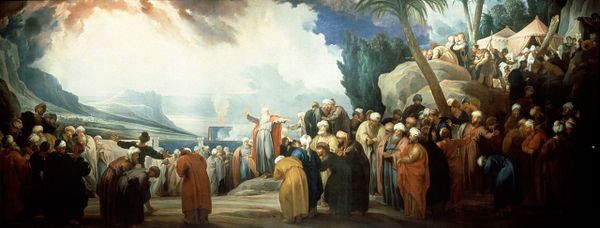
Advertencia y bendición a las doce tribus
Tras muchos años, los descendientes de los hijos de Jacob que vivían en Egipto se multiplicaron hasta tal punto, que el Faraón se sintió amenazado por su cantidad y su poder. Los esclavizó y ordenó que todos los varones hebreos fueran ahogados al nacer.
Moses was born during this perilous time, but his mother saved his life by setting him afloat in a basket on the Nile. Pharaoh’s daughter found him and raised him as her own son. In answer to a call from God, Moses led his people out of Egypt toward the Promised Land. After forty years of wandering in the wilderness, the Hebrews, under the leadership of Joshua, entered and conquered the Promised Land, the land of Canaan.
Before his parting, Moses gives a blessing and an admonishment to these twelve tribes and the passes the torch to his chela, Joshua. In these parting words, Moses rebukes them and prophesies that although he has admonished them to walk uprightly and to choose life and not death, they will backslide, they will become stiff-necked, they will forget his word as soon as he has departed. These words are recorded in the final chapters of Deuteronomy.
Moses warned them against mingling with the neighboring nations, taking up their gods, intermarrying with them. These neighboring nations were the nations of the Nephilim and the fallen ones. And Moses predicted that they would enter into associations with them, walk in their ways and follow their idolatry. He predicted that if they did so, therefore choosing their cult of death, the curses of the LORD would be upon them—meaning that judgment, or karma, would come upon them for their actions.
At the conclusion of the reading is Moses’ blessing of these twelve tribes before his transition. We see the great love of Sanat Kumara through Moses for each of those twelve tribes. Previously there had been the rebuke and the statement of karma and their faults. Yet in this blessing, each one is praised, and there is a prophecy given as to what they will accomplish. These prophecies are veiled and they are based on symbolism. The seal of that blessing gives us the divine plan and the opportunity for victory of each of these twelve tribes, as they each hold one line of the twelve points on our cosmic clock of initiation.
Moses was the Great Guru unto the twelve tribes of Israel. We are living in an hour when all of the promises of God through the prophets for the restoration of the memory of the tribes and the restoration of the Promised Land are about to be fulfilled—prophecies concerning the transmutation of karma couched in the words, “I will remember their sin no more.”[7]
The dispersion
Joshua divided the conquered territory among the tribes according to God’s direction. The only tribe that did not receive territory was the tribe of the Levites. The Levites led the people in worship, were responsible for teaching God’s Law and performed other religious functions. The twelve tribes formed a loosely knit confederacy bonded together by their religious covenant with God. They were each in charge of their own territory, but in time of crisis they banded together to fight a common enemy.
After Joshua passed on, the tribes were led by judges. The judges were primarily charismatic military leaders raised up by God to defend the people against the encroachments of neighboring nations. During the period of the judges, the Israelites began to worship pagan gods, the gods of materialism, the gods of the fallen angels. God punished them for their idolatry and apostasy by allowing other nations to harass and attack them. These invaders seized their land and crops and exacted tribute from them.
When the Israelites repented and obeyed God’s laws, the LORD empowered the judges to champion their cause, and once again they enjoyed peace. The pattern of disobedience then punishment, repentance then deliverance was repeated over and over again. The leadership of the judges ended when the people demanded of Samuel, the last judge of Israel: “We will have a king over us that we also may be like all the nations.”[8] They believed their tribal confederacy was not strong enough to ward off the growing threat of Philistine armies.
Samuel told the people that their desire for a king was a rejection of God. In fact, it showed a waning of their attunement with the living Presence of God with them and their forgetfulness of God’s continual deliverance as he manifested himself to them through Archangel Michael, Archangel Gabriel and all of the heavenly hosts. And so, they looked for power in a human being, a leader and a king.
Samuel reluctantly consented to their demand by anointing Saul king but warned that a monarchy would bring them oppression. When Saul died, David became king of Israel after a short period during which Saul’s son ruled over the northern tribes. Solomon succeeded his father, David, to the throne, and although he brought prosperity and peace to the land, he also placed a heavy burden on the people through taxation and slavery.
Shortly after Solomon’s death in about 922 B.C., the ten tribes in the North rebelled against Solomon’s son and successor to the throne, Rehoboam. These tribes formed their own kingdom, called Israel, ruled by their own king. The tribes of Judah and Benjamin made up the smaller and poorer Southern Kingdom, called Judah.
For about fifty years following the division of the kingdom, Israel and Judah fought a civil war over border territory. Partly as a result of their squabbles with each other, the two kingdoms lost territory to neighboring nations. In the coming centuries, Israel and Judah became more and more vulnerable because of their backsliding. The prophet Hosea, preaching in the Northern Kingdom, decried the growing social corruption, worship of pagan gods and moral decay. He warned the Israelites that they had broken their sacred covenant with God and would pay the price.
In 721 B.C. the Assyrians under Sargon II conquered the Northern Kingdom of Israel and forcibly deported most of the people to Assyria. This was the end of the Northern Kingdom. Because the fate of the ten northern tribes after they were deported is unknown, they are referred to as the ten lost tribes. It is widely believed that they never again returned to their homeland.
With the demise of the Northern Kingdom, Judah became a vassal of Assyria, and then, in the seventh century B.C., it became a vassal of the Babylonian Empire. During this turbulent time, the prophet Jeremiah preached God’s imminent judgment upon Judah for her sinfulness. He warned that if the people did not turn wholeheartedly to their God, they would meet the same fate as Israel at the hands of an “evil from the north.”[9]
Judah, like Israel, was guilty of idolatry, apostasy, corruption and moral degeneracy. They had erected altars to a host of foreign gods whom they worshiped alongside the LORD. The fertility cult’s sacred prostitution was practiced in the Temple at Jerusalem. Some of the people even took part in the pagan practice of human sacrifice, making “their sons and their daughters to pass through the fire unto Molech.”[10]
The LORD’s prophecy through Jeremiah was fulfilled. The king of Judah rebelled against the Babylonians, and in 597 B.C. the Babylonian king Nebuchadnezzar besieged Jerusalem and deported the king and leading men of Judah. In 587 B.C., the Babylonians totally destroyed Jerusalem—looting, burning every building including the Temple, and deporting all but a few inhabitants. A third deportation took place in 582 B.C. Although they had been taken from their homeland, the conditions for the exiles were not unfavorable. The Jews became farmers, merchants, traders, soldiers, even government officials, some rising to positions of wealth.
The coming of the Messiah
In 538 B.C. the Persian king Cyrus, conqueror of Babylonia, issued a decree permitting the Jews to return to Jerusalem and rebuild the Temple. Most of them had forgotten and were not concerned with their inheritance; only a small remnant of the tribes returned, most of them from the tribes of Judah and Benjamin. They brought the Temple vessels that had been stripped from them in 587 B.C., and the Temple in Jerusalem was rebuilt.
This was the time of preparation for the coming of the Messiah. As we now understand, the preparation for Jesus’ coming had begun with Sanat Kumara, Abraham, Isaac, Jacob, the twelve sons. But what happened to them?
Living at this particular period in Egypt and in the Fertile Crescent were a conglomeration of peoples. Some of them were Baal worshipers, worshipers of Ashtaroth. They were a laggard generation, descendants of Atlantis. They were the ones who condemned the prophets, who rejected Noah, who mocked him.
And amidst these laggards who had come from other spheres, who had lagged behind their planetary evolutions, there was born a people of great light, people who had come with Sanat Kumara, people who were of the angelic hosts. They were mingled all together in the Fertile Crescent, and the great patriarchs and the prophets were constantly trying to draw the people of light out from among the people of darkness. They were even given the decree that they should not intermarry with those who worshiped idols and other gods. And they were constantly reminded of who their God was.
But they did not heed their teachers and prophets. There was the mingling of the seed of light and darkness—the very same thing we see today in every nation on earth. They were overcome by the Serpent. They sinned. They rebelled against God. Therefore, they lacked the community and the physical focus of the Great White Brotherhood.
What was left was a tiny remnant of lightbearers, and so, instead of coming into the kingdom of Israel, Jesus was born under the Roman Empire. Immediately facing the persecution of Herod, he and his family had to flee to Egypt.
Jesus came as a lone avatar, and he had to stand against the entire Babylon of Church and the Babylon of State. He stood against the priesthood that had invaded the people of Israel, that had destroyed the real essence of the teaching of Moses and Sanat Kumara. Because they had already lost their true race and had mingled with the peoples of Canaan and of the Fertile Crescent, most of the twelve tribes had compromised their own Christ consciousness given to them by their prophets. Therefore, they could not recognize the Christ in Jesus.[11]
Nevertheless, he came, and when he raised up his apostles and gave them his mantle to go after the lost sheep of the house of Israel (Matt. 10:6), he was sending them to find the lightbearers of the lost tribes, those who had lost their identity, forgotten who they were and were now scattered abroad. He sent them throughout Asia Minor. They went as far as India and Italy. They went throughout the entire known world, searching for the lightbearers.
The twelve tribes today
What happened to the twelve tribes? They were scattered across the face of the earth following the ministry of Jeremiah.
The ten northern tribes have reincarnated among those who have been called the “Gentiles.” Some have sought to trace physically the migration of these tribes to Europe, Russia and the British Isles. They trace the origins of the shields and crests of the different cities and states to those of the twelve tribes, whose emblems are derived from the final blessing Jacob gave his sons. They also see the prophecies of Jacob and Moses about the different tribes fulfilled in the history of different European nations.[12] Whether the tracing is proven through a physical lineage or not, we do know that they remained intact as a soul mandala. They have descended, many of them walking according to the Christian faith, accepting the Messiah and yet forgetting their origin as members of those ten tribes.
The tribes of Judah and Benjamin in the south and some of the Levites who were with them remembered they were Jews but did not perceive the fulfillment of the prophecy of the coming of Messiah.
The members of the twelve tribes are Sanat Kumara’s legions. They have been carrying this flame of the true Israel through all the mystery schools, through Camelot, through the school at Crotona, through the ashrams of India and Asia. Everywhere there has been a nucleus of lightbearers and the acknowledgment of the Source and the Mediator (The I AM THAT I AM and the Christ), there has been the gathering, once again, of the Israelites scattered over the face of the earth as the seed of Abraham, which became the seed of Christ through David.
The Bible is a record of how these souls who came through Abraham succeeded and how they failed. The twelve tribes have an assignment, and they are born to deal with a certain energy. We see that their failure throughout the Old Testament until their final dispersion is based on the fact that they have not seized this assignment and fulfilled it.
This is the karma that we have today, as we have inherited the karma of those twelve tribes. As the lightbearers, the ones who bear the seed of light, we have the responsibility for the transmutation of everything we read in the Old and the New Testaments.
Our mission today is to realize who we are, where we fit into the mandala of these twelve tribes and then to balance the karma that the twelve tribes have made. In balancing that karma through the violet flame, through our invocations, we eliminate the forcefields, the islands of darkness that keep the tribes separated and also keep the members of each tribe separated from one another. The burden of this karma is why the tribes have no sense of identity today, and the real members of the tribes have no idea who they are.
Jesus Christ took embodiment to go after the lost sheep of the house of Israel, those who had lost their memory of having ever been part of the light of Sanat Kumara. And we, today, are a remnant of those tribes. The lightbearers incarnating in every age in East and West are the very same members of the twelve tribes of Israel.
Old Testament prophecy, then, is our heritage. Coming out of Egypt, crossing over the Red Sea, going into the Promised Land and then being disobedient and being chastised—all of this is what we have gone through collectively in our incarnations of the West.
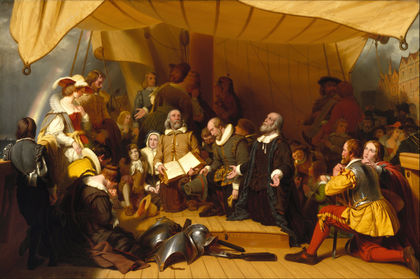
The New World: promised land for the gathering of the twelve tribes
As we trace the history of the reincarnated tribes, we find a very special destiny for the sons of Joseph and the two tribes of Ephraim and Manasseh. These two sons of Joseph, having the highest blessing, the very personal blessing of Jesus Christ in the person of Joseph, having his seed, are the ones called to reverse the sin of the other brothers of the house of Jacob. The other brothers had great sins in their day and unto the present hour.
We also see in Joseph that he married the daughter of an Egyptian priest, and therefore the seed of Egypt and of the ancient Pharaohs, even coming down from Ikhnaton and Nefertiti and the religion of monotheism, is among these particular tribes. They went to the British Isles and became the nucleus of the English-speaking people in Britain, America and the world.
It was given to them to carry the cup of the Christ consciousness and to bring the English language all over the world through colonization and through discovery, so that when the teachings of the I AM THAT I AM would be given again to the children of Israel, they would come through the English language, the language chosen because it most nearly reflected the angelic tongue that is the source of the original teaching to the original people of Israel. So it was the destiny, then, of the English-speaking peoples to carry that Christ consciousness to the new world.
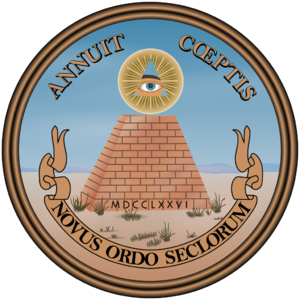
The new world, America, is the land that was promised by the LORD God to the children of Israel. They were told that they would be brought into a new land and would be given a new dispensation. Early records in the history of the nation show that the founding fathers of America knew that they were the people of Israel, that they were the inheritors of this promise and that they had come to a new world to found the New Israel, the New Jerusalem, the new mystery school, the new place of dispensation. We see this symbolized in the Great Seal of the United States, with the All-Seeing Eye of God in the capstone of the pyramid, focalizing the mission of the twelve tribes.
Even in the name, America, there is revealed the origin and destiny of the nation. The letters of the name, when rearranged, spell I AM Race. This is the race of the children of Israel who have accepted their God-reality, who know God as the I AM that was revealed to Moses.[13] They have been called to America as the gathering together of the elect from the four winds,[14] from the four corners of the earth, to bring forth the Christ consciousness and then to take that Christ consciousness to every nation. This is the mission of the Israelites in the United States, founded upon the mystery school of the thirteen—thirteen founding states, Christ and his apostles.
So we see the emigration, vast lines of pilgrims, first from the British Isles, the brothers Manasseh and Ephraim, and then from the tribes of all the different European nations becoming the foundation of the United States.
Tracing the seed of light
We go back, then, to the very history of Jacob and the coming of the twelve tribes to discover our own history. As we understand our history, we understand our blessing. When we study the promises of the prophets and the patriarchs to us, then, when we give our invocations, we are standing upon the rock of Christ, and we have the confirmation of the Word through the flame of the ark of the covenant.
These tribes have a destiny to fulfill. That destiny is to unite under the banner of the I AM THAT I AM—the Presence of God individualized in each one of us in whom there burns the flame of God. Through the Spirit of the living Christ, we are destined to become a major world power.
The twelve tribes of Israel today are not a lineage of twelve tribes by blood, but their descent can best be explained by reincarnation. The seed of Abraham was scattered. They continued to reembody, always carrying that seed, and therefore, they may not be in bodies that resemble the Semite people. They may very well be Chinese or African or Indian or any race. But they have come again.
The seed that they carry is the nucleus of the Christ consciousness. All who have the Christ consciousness are of this seed. And you find that there is a dividing line. You find people of every religion who deny that Flame, that essence, that Spirit, and deny the opportunity for the individual to become that Christ. Others have known from the beginning that they were Christ, they were that Flame, they were that Reality. Others have known it by another name and have intensely resisted the name Christ, but when they understand the true meaning, then they realize that that is the indwelling Presence with whom they, also, have communed.
In the seventh chapter of the Book of Revelation, we read the prophecy of the sealing of the servants of God in their foreheads, twelve thousand from each of the twelve tribes, a total of 144,000. They also appear in chapter 14 as those gathered around the throne of the Lamb, who is Sanat Kumara. And so, in Revelation there is a continuing chronicle of the twelve tribes and of their overcoming of all that is revealed.
Our destiny as the twelve tribes
The twelve tribes of Israel have not maintained a continuous identity over these thousands of years. But our great victory lies in the fact that the identity is in the Inner Flame; no one can take from us the flame of light, the Flame of God, the original Word, the memory of the teachings of East and West, the instantaneous rapport with the I AM THAT I AM and the recognition that Christ was not alone in Jesus but that he is in us. When you find people that have that awareness, you are finding the members of the house of Israel and Judah.
The genius of the twelve tribes is in every nation. All of the nations are forcefields for the development of the Christ consciousness through the twelve tribes, and each of the nations of the earth is an opportunity for the lightbearers to master a certain initiation of a certain chakra.
We find today that the twelve tribes have been caught up and lost their identity as the tribes of Israel and have identified themselves now within their many nations. They have not realized that they have put on their nationhood to identify in that nation, to set the example of the lightbearer to the people. The Ascended Master Saint Patrick has come to help us make contact with the lightbearers of all nations, to alert them to the message, to alert them to the teachings of the ascended masters, to bring them together so that they can form the nucleus for the victory and the salvation of earth. Until we make this contact, identify our brotherhood, identify our community, we do not sense our strength.
He has said:
I AM the defender of the Woman in this age. I come, then, to secure a place for her children—children of the Mother who have come out of the land of Israel so long ago that they have forgotten their source and their common origin as the seed of Abraham, of David and of Christ, the Messiah of all.
I come, then, to deliver the mandate of truth, and it is this, that the children of the light must be one, that all who have gone forth out of the nucleus of the sacred fire of Jerusalem to the four corners of the earth now are called to be sons and daughters of God. And yet they remain as prisoners of their respective nations—prisoners in the sense that they are bound by certain customs and laws and political and religious ideologies, whereby they have forgotten the one true law of the I AM THAT I AM.
I center, then, the energies of the fiery core of my being here in the heart of the city, the New Jerusalem, and I place the magnet of my devotion to the Mother for the calling in of the rays of the house of the LORD, the rays of Ikhnaton, who saw the one God and the people of God as one, the rays that will call back the one hundred and forty-four thousand flames of the twelve tribes of Israel....
All of this warfare and this division that has been created as the divide-and-conquer tactic of the fallen ones, even midst the brethren of Ireland and of the British Commonwealth of Nations and throughout Europe and the Eastern countries, all of this is to this one purpose, children of the Light—now understand it is to keep the children of Israel separate and apart in the last days.
For in every nation there are lightbearers. But the fallen ones and those who have never elected to be one with the light of God, these live also among these nations. And the children of God, instead of identifying with the life and the Body and the Blood of Christ, have begun to identify themselves as members of these nations. And therefore, they see their national loyalties as greater than their loyalty to the one purpose of the Ancient of Days, Sanat Kumara, which was to keep the flame of life for the evolutions of this earth.
See, then, that you understand that for the defense of the karma and the dharma of the people among whom you have embodied, you must call yourself an American, an Italian, a Chinese or a Russian, but for the purposes of the salvation of earth, you must understand yourselves as the deliverers of the nations.
The cutting free of the nations by the action of your sword of life is your mission and your goal. It is to free the nations to behold within themselves, and not to come under, then, the boot and the darkness of those who proclaim a one-world government and yet do it not in the name of Christ, but in the name of a scientific humanism.
They do err, and their divide-and-conquer tactics have taken a new course in this age. It is to play upon the reality of the inner understanding of the people of God that indeed the earth is one, and to carry that understanding into a perversion whereby the karma and the dharma of the people of the nations is destroyed as they are forced to come into a totalitarian system whereby they are divested of their natural genius and their calling from the mansions of the Father’s house....
See also
Sources
Mark L. Prophet and Elizabeth Clare Prophet, The Path of Brotherhood, pp. 123–50.
- ↑ Santiago 2:23.
- ↑ Génesis 12:2
- ↑ Génesis 15:5.
- ↑ Génesis 15:12-16.
- ↑ Génesis 26:2-5.
- ↑ Génesis 32:24-28.
- ↑ Heb. 8:12.
- ↑ 1 Sam. 8:5.
- ↑ Jer. 4:6.
- ↑ Jer. 32:35.
- ↑ The essence of the original teaching of Moses and Sanat Kumara was kept by the Essene communities, who were only a small minority in the Holy Land. Jesus’ parents were part of this community, which provided the spiritual cradle for Jesus’ incarnation. It is believed by many scholars that the early Christian community grew out of the Essene community.
- ↑ See, for example, Raymond Capt, Jacob’s Pillar (Thousand Oaks, Calif.: Artisan Sales, 1977); Colonel J. C. Gawler, Dan: Pioneer of Israel (Thousand Oaks, Calif.: Artisan Sales, 1984).
- ↑ Exod.3:14.
- ↑ Matt. 24:31; Mark 13:27.
- ↑ Saint Patrick, April 3, 1977.

